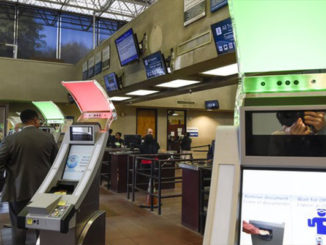
In the first four months of the Trump administration, U.S. Immigration and Customs Enforcement greatly overstated the effectiveness of a program in which local law enforcement agencies partner with the federal government to facilitate the deportation of county jail inmates suspected of being unauthorized immigrants, according to a new report analyzing the agency’s data.
On its website, ICE publicly claimed that the Secure Communities program, which President Donald Trump rekindled upon taking office after the Obama administration had scaled it back, led to 43,300 “criminal aliens” being deported from January to March.
ICE’s own data, however, shows that only 10,893 immigrants were deported through the program during that period and that only 4,850 of those had serious criminal records, according to the report by Syracuse University’s Transactional Records Access Clearinghouse, which analyzes data obtained through regular Freedom of Information Act requests.
ICE spokeswoman Sarah Rodriguez said in a statement that the report is “deceptive and, once again, presents filtered and augmented data points to incorrectly describe ICE statistics.”
“Secure Communities remains a valuable tool in identifying and arresting criminal aliens as they are encountered by our criminal justice system,” she said.
But after the report came out, ICE edited the page on its website cited in the report by expanding the date range for which the 43,300 total applied, ending at the end of June rather than March.
The report comes as Austin and other Texas cities fight in federal court over a new state law, Senate Bill 4, that bans so-called sanctuary cities that decline to assist with federal immigration enforcement.
The law makes it illegal for police departments or sheriff’s offices to decline ICE “detainer” requests, which are the centerpiece of the Secure Communities program. Through detainer requests, federal agents ask local jails to hold inmates suspected of being unauthorized immigrants for an additional 72 hours after they otherwise would have been released to facilitate their potential arrests by ICE officers.
The new law also makes it illegal for police agencies to prohibit officers from inquiring about subjects’ immigration status.
The 5th U.S. Circuit Court of Appeals in New Orleans this week is hearing arguments about the law’s constitutionality in what could become the first “sanctuary cities” case to reach the U.S. Supreme Court.
Secure Communities began under the Bush administration and was replaced under Obama by the Priority Enforcement Program, which limited detainer requests to those accused of serious crimes.
Days after taking office, Trump relaunched Secure Communities through an executive order, and his administration has cast federal-local partnerships as an essential tool in its crackdown on illegal immigration.
The administration has also sought to withhold related data that were regularly released during Obama’s tenure. On behalf of ICE, the Justice Department last week sought court permission to withhold details about cases involving detainer requests, making it more difficult to determine whether they are effective enforcement tools at a time when they are taking center stage in the debate over how to control illegal immigration.
Past data shows that, despite the agency’s claims, detainer requests play a small role in ICE’s enforcement operations. The most recent ICE data shows that fewer than 1 percent of deportation cases were facilitated by detainers, according to the Syracuse report.



